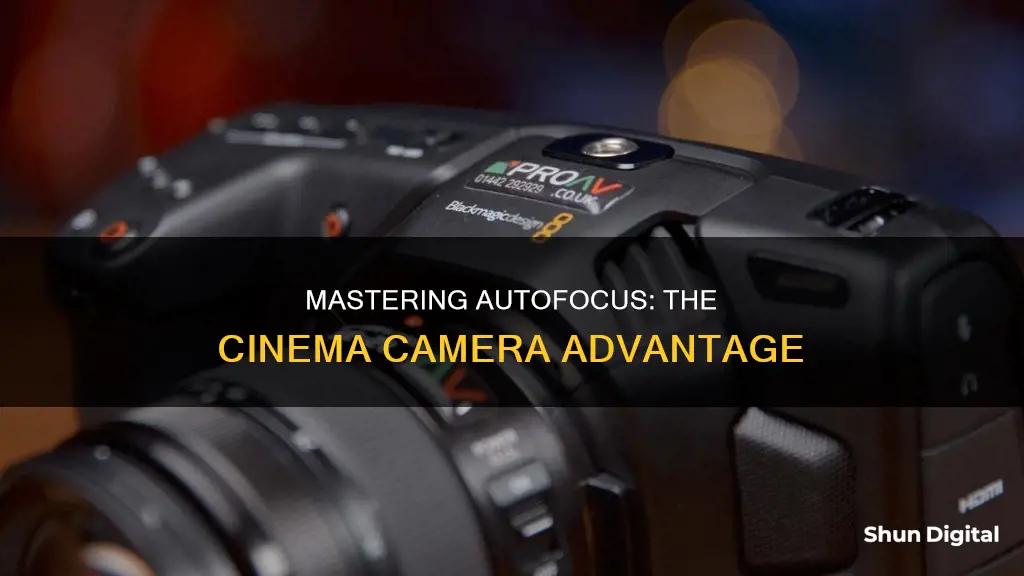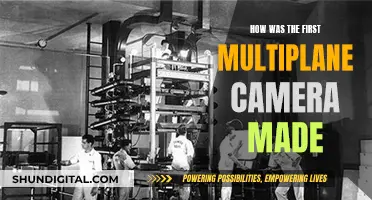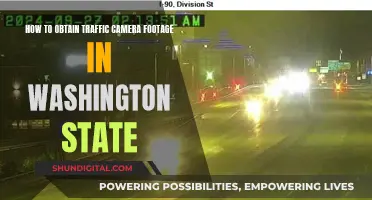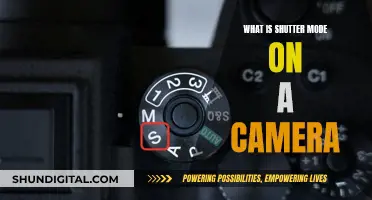
Autofocus is a feature available on some cinema cameras. While it is commonly used in documentary filmmaking, it is less common in narrative filmmaking, where there is a stigma associated with using autofocus. Cinematographers typically prefer to manually focus their shots, and higher-end cinema prime lenses often do not support autofocus. However, autofocus can be beneficial in certain situations, such as when shooting with a gimbal, filming unpredictable subjects like animals or children, or when the camera operator is also the subject, as in vlogging or self-shooting.
| Characteristics | Values |
|---|---|
| Autofocus Usage | Autofocus is more commonly used in documentary filmmaking than in narrative filmmaking, where there is a stigma against it. |
| Autofocus Accuracy | Autofocus is not 100% accurate and may become confused if it loses sight of a subject's face. |
| Autofocus Benefits | Autofocus can be beneficial when using gimbals, filming uncontrollable subjects, or shooting higher resolutions. |
| Autofocus Technology | Phase detection and contrast detection technologies are combined in Sony's Hybrid AF system for faster, more reliable, and precise autofocus. |
| Autofocus Face Detection | Sony's Hybrid AF includes Face Detection AF with Face Priority AF and Face Only AF options, which can be useful in documentary or narrative work. |
| Autofocus Speed | The AF Transition Speed feature allows users to adjust the speed and responsiveness of the autofocus, with levels ranging from 1 (slowest) to 7 (fastest). |
| Autofocus Subject Shift | The AF Subject Shift Sensitivity feature adjusts the sensitivity of how fast the autofocus moves from one subject to another, with levels from 1 (locked on) to 5 (most responsive). |
What You'll Learn

Autofocus is useful for shooting uncontrollable subjects like children and animals
Autofocus is incredibly useful when filming uncontrollable subjects like children and animals. The focus puller or self-shooter can mark areas on the lens and the ground to be prepared for the subject's movement. However, autofocus can track the subject and keep them in focus while they move.
When filming children and animals, it can be a guessing game to dictate which way to focus the lens, and autofocus can be incredibly useful in these situations. For example, when filming dogs playing in the garden or children chasing after them, the autofocus will ensure the subjects stay in focus even when they move.
Autofocus is also beneficial when using a gimbal, as it can be challenging to manually focus the lens while moving the camera. In addition, autofocus can be helpful when using a shallow depth of field, as it can be tricky to judge where to focus with a still lens.
While autofocus has its limitations and may not be suitable for complex work or scenes with multiple moving subjects, it can be a valuable tool when filming uncontrollable subjects like children and animals.
Adjusting Your Camera: Master Similar Modes
You may want to see also

Autofocus is beneficial when using a gimbal
Autofocus is a useful feature when shooting with a gimbal, especially for solo shooters. When using a gimbal, it is not recommended to touch the camera as it may disrupt the balance. Therefore, manually focusing the lens while moving the gimbal can be challenging and may result in the camera being thrown off balance.
A common workaround for this issue is to use an extreme wide-angle lens, set the focus to infinity, and increase the depth of field. However, this approach may not be desirable if you want to use a shallow depth of field with a tighter focal length. In such cases, autofocus becomes invaluable in ensuring that the subject remains in focus while you move with them.
Autofocus is also beneficial when shooting with a gimbal in situations where you need to track a specific subject, such as in documentaries, sports events, or when filming unpredictable subjects like children or animals. With autofocus, you can rely on the camera to track and maintain focus on the subject, even when they are in motion.
Additionally, when shooting with large formats or 4K video, it can be extremely difficult to focus manually, especially with the naked eye. In such cases, the autofocus functions on your cinema camera can be a great help. Modern autofocus systems have improved tracking accuracy and facial recognition features, making them more reliable.
While autofocus has its advantages when using a gimbal, it is not always perfect and may not be suitable for all situations. For complex sequences or specific setups, manual focus with a focus puller may still be preferred. Ultimately, the decision to use autofocus or manual focus depends on the specific requirements of your shoot and the creative choices you want to make.
Charging the FinePix XP120: A Step-by-Step Guide
You may want to see also

Autofocus is ideal for shooting documentary B-roll
Documentary B-roll footage can be chaotic and hard to capture. It can involve precarious situations and wild scenarios. In these situations, autofocus can be a great tool for keeping your subjects in focus. For example, the Sony FX6 has 629-point focal plane phase detection AF, which can be used for intelligent tracking and on-sensor phase detection. This will help keep your subjects in focus, no matter how crazy things get.
Autofocus is also beneficial when shooting with a gimbal. Shooting from a gimbal usually involves a moving camera and a moving subject. Without an expensive follow-focus and monitoring system, autofocus is usually the best option. Keeping shots wide also helps since changing targets is less noticeable.
Autofocus technology has come a long way, especially in face tracking and low-light autofocus performance. For example, the Sony FX3 has high-precision touchscreen AF and high-speed readout capabilities. This makes it simple to set up and allows the cinematographer to focus on other aspects of the shoot, such as lighting, audio, and direction.
While manual focus is often preferred in cinematography, autofocus can be a valuable tool in certain situations, especially when shooting documentary B-roll. It can help cinematographers capture the best shots and focus on other important aspects of the shoot.
Understanding Your Camera's Battery Symbol
You may want to see also

Autofocus is useful for shooting interview footage
Secondly, autofocus can help ensure that the subject remains in focus, even if they move around during the interview. This is particularly important when using a shallow depth of field, as small movements by the subject can result in them falling out of focus. Autofocus with face detection can be invaluable in such situations, as it allows the camera to track the subject's face and adjust focus accordingly.
Thirdly, autofocus can be advantageous in low-light conditions. With autofocus, the camera operator doesn't have to worry about manually adjusting focus in dimly lit environments, which can be challenging and time-consuming. Autofocus systems have improved significantly in recent years, with advancements in face tracking and low-light performance, making them more reliable and accurate.
Lastly, autofocus can save time and effort during the shoot. By eliminating the need for constant manual focus adjustments, autofocus allows the camera operator to work more efficiently, especially when shooting with multiple cameras or in a fast-paced environment.
However, it is important to note that autofocus is not perfect and may not be suitable for all interview situations. In some cases, manual focus may still be preferred, especially when precise control over focus is required. Additionally, not all lenses support autofocus, especially high-end cinema prime lenses.
The Evolution of Waterproof Cameras: A Historical Perspective
You may want to see also

Autofocus is better for shooting higher resolution
Autofocus has improved significantly in recent years, and while it may not be perfect, it can be incredibly useful in certain situations. One of the key advantages of autofocus is its ability to handle higher-resolution recording.
With the increase in resolution, manual focus can become less precise and fine, resulting in footage that is less crisp and clear. Autofocus, on the other hand, can provide greater precision and accuracy, especially when combined with advanced autofocus systems like dual-pixel autofocus or phase-detection AF. These systems enable the camera to make minute adjustments and track subjects more effectively, resulting in sharper and more defined footage.
The Sony Cinema Line, including the FX3, FX6, and FX9, are excellent examples of cameras with advanced autofocus technology that excels in higher-resolution recording. The FX9, for instance, offers enhanced Fast Hybrid AF, providing unprecedented speed, smoothness, and precision. This level of autofocus performance ensures that even the most animated interviewees or rapidly moving subjects remain in focus.
In addition to precision, autofocus can also save time and effort, especially for solo operators or "one-man-bands". It eliminates the need for manual focus adjustments, allowing the operator to focus on other aspects such as lighting, audio, and direction. This can be particularly advantageous in documentary filmmaking, where chaotic and unpredictable situations are common, or in interview settings where subjects may move around a lot.
While manual focus is still preferred in certain situations, such as complex sequences requiring precise blocking and constant adjustments, autofocus has become a valuable tool for filmmakers, especially when shooting at higher resolutions. It allows for greater flexibility, precision, and the ability to capture clear and crisp footage, even in challenging and dynamic environments.
Charging Camera Batteries: A Universal Guide to Powering Your Device
You may want to see also
Frequently asked questions
Yes, many modern cinema cameras have autofocus functionality.
Autofocus is preferable when you are a one-man band, shooting B-roll for a documentary, shooting interview footage, shooting at a higher resolution, or vlogging/self-shooting.
Autofocus can be beneficial when using a gimbal, as it can be difficult to manually focus the lens while also moving the gimbal. Autofocus is also useful when filming unpredictable subjects, such as animals and children.
Autofocus is not 100% accurate and may struggle with complex sequences or multiple moving subjects within the frame. It also requires lenses with built-in autofocus support, which are not common for high-end cinema prime lenses.
Some examples of autofocus technologies and features include dual-pixel autofocus, phase detection autofocus, face detection autofocus, and hybrid autofocus, which combines phase detection and contrast detection.







